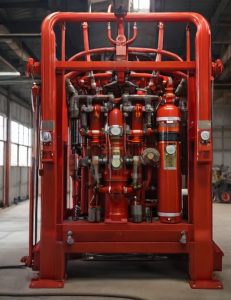![]()
Fire Immuniser
+91-7829629111
Email: info@variex.in
Varistor Technologies Pvt. Ltd.
Block-1, First Floor, Ardente Office One, Hoodi Circle, ITPL Main Road, Bengaluru, Karnataka 560048, IN
Advanced Fire Fighting System
Amid evolving fire risks, advanced fire fighting systems are crucial for safeguarding lives, property, and the environment. These innovative systems integrate cutting-edge technologies and sophisticated design principles to provide enhanced fire detection, suppression, and evacuation capabilities. Here's a closer look at the key components and benefits of advanced fire fighting systems.
Integrated Fire Detection and Alarm Systems:
- Advanced fire fighting systems feature state-of-the-art fire detection and alarm systems using sensors, detectors, and intelligent algorithms.
- These systems detect fires at an early stage, enabling prompt initiation of rapid response and evacuation procedures.
- Integration with building management systems allows real-time monitoring and remote control of fire detection and alarm devices, enhancing situational awareness and responsiveness.
Automated Fire Suppression Systems:
- Advanced fire fighting systems incorporate automated fire suppression technologies, such as water mist systems, gas-based suppression systems, and foam suppression systems.
- These systems detect and suppress fires quickly and effectively, minimizing property damage and reducing the risk of injury to occupants.
- Advanced suppression systems often feature intelligent control algorithms and multiple suppression agents to adapt to various fire scenarios and environmental conditions.
Smart Evacuation and Communication Systems:
- Integration with digital signage, emergency lighting, and public address systems enables targeted communication and direction of evacuation routes based on the location and severity of the fire.
- These systems may also incorporate advanced tracking and monitoring technologies to account for occupants and facilitate safe evacuation procedures.
Remote Monitoring and Control:
- Advanced fire fighting systems leverage remote monitoring and control capabilities to enable proactive management and maintenance of fire safety infrastructure.
- Owners and managers can remotely monitor system status, receive real-time alerts, and conduct diagnostic tests for optimal performance.
- Remote control features enable quick system adjustments, emergency protocol activation, and responder coordination, enhancing overall responsiveness.
Predictive Analytics and Risk Assessment:
- Advanced fire fighting systems use predictive analytics and risk assessment tools to identify fire hazards and vulnerabilities in buildings and infrastructure.
- By analyzing sensor data, incident records, and building occupancy patterns, these systems proactively identify concerns and implement targeted measures to reduce fire risks.
Integration with Building Automation Systems:
- Advanced fire fighting systems seamlessly integrate with building automation systems (BAS) to achieve greater operational efficiency and coordination.
- Integration with BAS allows centralized control and monitoring of fire safety devices, HVAC systems, access controls, and other building functions, optimizing resource allocation during emergencies.
Continuous Improvement and Adaptation:
- Designers continually improve and adapt advanced fire fighting systems to address emerging fire risks and regulatory requirements.
- Regular system assessments, performance evaluations, and training programs ensure fire safety personnel possess the knowledge and skills needed to effectively operate and maintain advanced fire fighting systems.
In conclusion, advanced fire fighting systems represent a proactive approach to fire safety, leveraging advanced technologies and comprehensive strategies to mitigate the risks posed by fires.
By integrating intelligent detection, suppression, evacuation, and communication capabilities, these systems enhance overall preparedness and resilience, helping to minimize the impact of fires on people, property, and the environment.
Frequently Asked Questions
What are advanced fire fighting systems?
- Advanced fire fighting systems integrate cutting-edge technology and design principles to enhance fire detection, suppression, and evacuation.
What components are typically included in advanced fire fighting systems?
- Advanced fire fighting systems encompass integrated fire detection and alarm systems, automated suppression, smart evacuation, remote monitoring, predictive analytics, and BAS integration.
How do advanced fire detection and alarm systems work?
- Advanced fire detection and alarm systems utilize sensors, detectors, and intelligent algorithms to detect fires at an early stage. They provide real-time alerts and facilitate rapid response and evacuation procedures, enhancing overall situational awareness and responsiveness.
What types of automated fire suppression systems are available in advanced fire fighting systems?
- Advanced fire suppression systems may include water mist systems, gas-based suppression systems, and foam suppression systems. These systems quickly detect and suppress fires, minimizing property damage and reducing the risk of injury to occupants.
How do smart evacuation and communication systems enhance fire safety?
- Smart evacuation and communication systems provide clear and timely instructions to building occupants during fire emergencies. They integrate with digital signage, emergency lighting, and public address systems to direct evacuation routes according to fire location and severity, ensuring safe evacuation.
Can advanced fire fighting systems be remotely monitored and controlled?
How do advanced fire fighting systems adapt to emerging fire risks and regulatory requirements?
- Advanced fire fighting systems continuously improve and adapt to emerging fire risks and regulatory requirements. Regular assessments, evaluations, and training programs ensure fire safety personnel possess the knowledge and skills to effectively operate and maintain these systems.
Final Say
We at VariEx.in or Variexonline.com have mastered the art of designing, installing, inspecting, and fixing automatic sprinkler systems with the help of our in-house team, which is capable of delivering the fire sprinkler services you need, whether large or small and at affordable cost.
To schedule a fire sprinkler installation, or you think our services could benefit your commercial property, contact us online or give us a call at, 7829629111










